Pancakes. I took them for granted when I was a kid. Now that I am all grown-up with adult onset allergies to both egg and gluten, pancakes could have become a product of my past like so many other foods I previously enjoyed.
I’m telling you all this because I want you to know I’m not on some vanity diet. No, I really do have to get creative making meals due to my allergies. So cooking, for me, has developed into a creative, culinary exploration in both sustenance and science. All that said, if you are vegan, gluten-free, or egg-free…these pancakes are for you! Even if you’re not deploying a similar diet, I’m betting you like my latest creation, “Upside Down Day” Gluten-Free Vegan Pancakes. My pancakes involve two meals: lunch and dinner.
 For Lunch:
For Lunch:
In your juicer, juice two large handfuls of chilled, fresh organic kale, two stalks of celery, two green apples, two large basil leaves, and two large bunches of grapes picked off their vine. Serve the juice with a refrigerated celery stalk to keep it cold, or drink it down. Preserve your pulp in the refrigerator for your pancakes you’ll make later. Run to Whole Foods and buy the King Arthur Flour Gluten Free Pancake Mix and Egg Replacer. 
For Dinner:
“Upside Down Day” entails serving breakfast for dinner. Hubby is never home when we celebrate “Upside Down Day.” While he is a fairly good sport, I’m pretty sure he would suck all the life out of the occasion and dangle his fabulous homemade tacos in front of our kids’ noses instead. (Plus he’s not invited because it’s imperative he never witness my slothfulness firsthand). If you haven’t figured it out already, “Upside Down Day” translates to “Lazy-Mom-Doesn’t-Really-Feel-Like-Cooking-Tonight-Day.” We used to celebrate the event more frequently when my daughter was little and I’d serve up bacon and eggs for dinner. “Upside Down Day” is a rare, special occasion in the Gould house now that I can no longer eat eggs due to my allergy. I can’t even cook eggs without itching…something about airborne allergens and what not. Who knew?
Anyway, I digress. Back to making “Dinner”:
Mix the gluten free pancake mix following box instructions, except substitute the egg for the egg replacer (following those box instructions as well) and also substitute the cow’s milk with VANILLA Almond Milk or VANILLA Soy Milk. Mix in the leftover pulp (where all the fiber is) from your lunchtime smoothie. Add more vanilla soy or almond milk to play with your desired thickness. Pour your batter onto a HOT, lightly greased griddle. I used canola oil because I was out of rice bran oil, my new “go to oil” because it cooks at high temperature points. You know your griddle is hot enough if a drop of water dances off of the surface. Pour your batter onto the griddle. My pancakes poured thick and imperfect, and I quite liked them that way even though they took longer to cook. If you like yours thick too, avoid burning them by turning them frequently once the batter has set. Use a tablespoon to scoop out the batter if you have OCD and prefer a perfectly round pancake. My husband’s banana pancakes are always perfectly round. Again, it’s your night to be a sloth, because you’ve kicked your husband out so you can make my pancakes.




I served ours the conventional way, with Earth Balance natural spread from Trader Joe’s and a hearty drizzle of Canadian maple syrup. My twelve-year-old son loved them, and he’s fairly hard to please, plus he got servings of both fruits and vegetables. I got to be a sloth and he ate his greens. It was clearly a win/win. If you try them, be sure to check back. Oh, and Happy Upside Down Day!
Enjoy!


Not sure if this will work, let's see. Its a movie a guy made about Trader Joes, the quirky funky wonderful grocery store. He made it with his cell phone, at one of the San Francisco stores.
I love TJ's. If you've been there, you know. If you don't have one near you, I'm sorry.
School will soon be out. The summer solstice is just around the corner. Hotter days will arrive along with the sounds of children playing outdoors on weekday mornings. I can still remember vividly many of the sights and sounds and smells and tastes and activities of summer from my childhood:
Watching fireworks exploding into color in the night sky and hearing their loud crackles and booms on the Fourth of July
Eating slices of succulent watermelon, juice dribbling down my chin, and spitting out the slick black seeds onto the sidewalk
Listening to the sound of cicadas in the heat of a summer day and the song of crickets at night
Slurping up raspberry lime rickeys and chocolate ice cream sodas
Running through the sprinkler, my bare feet squishing through wet grass
Picking feather-topped carrots, glossy-skinned peppers, scallions, and ripe tomatoes from my grandparents’ garden
The smell of hamburgers and hot dogs being cooked on an outdoor grill
The banging of my kitchen screen door as I ran outside to play
The tart, refreshing taste of my mother’s homemade lemonade
Feeling the cool wet sand beneath my feet at the seashore
Playing hide-and-go-seek with my cousins and friends on a balmy summer evening
With these images in mind, I thought this would be a good time to write poems about summer. Wouldn’t this also be the perfect time for children to write summertime poems? I think it would be a wonderful and enjoyable final writing exercise for the school year.
Well, here are two fine collections of poems to get kids thinking “poetically” about the warmest season of the year.

SUMMERSAULTS
Written & illustrated by Douglas Florian
Greenwillow/HarperCollins, 2002
Most kids love the poetry of Douglas Florian. I know my students did! SUMMERSAULTS contains twenty-eight lighthearted verses about such topics as fireflies, dandelions, swinging on a swing, bees, jumping rope, grazing cows, and baseball. The poems are rhythmic and rhyming and lots of fun to read aloud.
SUMMERSAULTS includes several excellent examples of list poems: What I Love about Summer, What I Hate about Summer, Greenager, Some Summers, No Fly Zone, Names of Clouds, Lost and Found, The Sea, and Dog Day. These poems could be used to inspire your students to write their own list poems about the different sights, sounds, smells, tastes, weather, and activities of summer. A teacher could brainstorm with her kids about all the things that come to mind when they think of summertime and school vacation. The teacher could write her kids’ contributions down on chart paper, guide the class in writing a class list poem about summer, and then ask them to write their own individual poems.
Here are excerpts from some of Douglas Florian’s list poems in SUMMERSAULTS.
From What I Love about Summer
Morning glories
Campfire stories
Picking cherries
And blueberries…
Skipping stones
Ice cream cones
Double plays
And barefoot days.
From What I Hate about Summer
Skinned knees
Ninety degrees…
Humid nights
Mosquito bites
Clothes that stick—
I hate that summer goes too quick.
From Lost and Found
Along the shore
I found six shells:
Two gray,
One white,
Three caramel…
Five feathers from
A seabird’s wings.
I wonder: Who
Has lost these things?
As a teacher, I believed it was always best to read the poetry of more than one poet to my students before asking them to write their own poems on a particular topic. Another collection of poems that would be great to share with kids prior to having them write their own summer poems is Rebecca Kai Dotlich’s LEMONADE SUN.
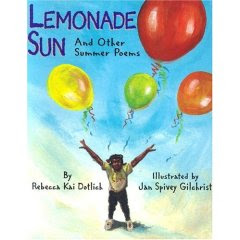
LEMONADE SUN AND OTHER SUMMER POEMS
Written by Rebecca Kai Dotlich
Illustrated by Jan Spivey Gilchrist
Wordsong/Boyds Mills Press, 1998
Dotlich’s writing style is different from that of Florian’s. While most of her poems celebrating summer are rhythmic and rhyming, they contain more imagery and figurative language. Let me provide you with some examples from her poems. She refers to jacks as tin bouquets/small bundles of piggyback stars. In Sunflowers, she compares the flowers to Golden guards/saluting/sky/garden kings/with chocolate eyes. In Dragonfly, she calls the insect a sky-ballerina/this glimmering jewel…with wings that you/could whisper through. In Backyard Bubbles, one of the loveliest poems in the collection, she compares a bubble to One fragile globe/of soapy skin/a glimmering/of breath within/a perfect pearl. Later in the poem she writes about another bubble that dances on a summer sigh/shimmering with shades of sky.
Dotlich includes other poems about lemonade, a lemonade stand, bumblebees, playing marbles, dandelions, pinwheels, jumping rope, going barefoot, jellyfish, a firefly, and fireworks. The poetry in this book definitely takes me back to the summer days of my childhood
Here are two poems from LEMONADE SUN
LEMONADE SUN
Popsicle stains.
Fudgesicle fun.
Strawberry sizzle—
Lemonade sun.
I will leave you with Dotlich’s poem SUMMER GREETINGS.
Today’s the day
that summer comes.
Good-bye to cold;
hello to sun!
Hello to rose
and vines of green,
to lettuce leaves—
oh, hello beans!
Today’s the day
for climbing trees,
for jumping rope
and skinning knees,
for swinging high
and skipping fast,
and reading
books
outside
at last.
May we all have fun reading outside in summer!
Note: I would like to thank Rebecca Kai Dotlich for giving me permission to print the full text of two of her poems in my Poetry Friday post.
During the month of April, Tricia at The Miss Rumphius Effect posted some blog articles about children exploring the natural world—and how, all too often, children seem to have much less of a connection to the world of nature around them. Our children today often spend many of their hours outside of school—inside. Yes, they are inside watching television or playing video games instead of playing with friends outdoors and climbing trees, picking wildflowers, watching ants crawling in and out of anthills, investigating the life in a pond, and stopping to listen to the different sounds of summer like cicadas stinging the still air.
From the Miss Rumphius Effect
Break a Leg-Climb More Trees!
Exploring the Natural World-Part 1
Exploring the Natural World-Part 2
Exploring the Natural World-Part 3

As I was exploring the website of Joyce Sidman, one of our best writers of nature poetry for children, I came upon Touching the World: The Importance of Teaching Poetry, a wonderful article she wrote and has reprinted from the Spring 2002 issue of Riverbank Review. She touches on some of the same things Tricia does in her blogs. I have an excerpt of the Joyce Sidman’s article below.
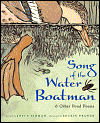
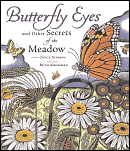 I
I
I face a roomful of fifth or sixth graders on the first day of a week-long poetry residency armed with three things: an activated imagination, a handful of poems, and a random object from the classroom, like a stapler or a roll of tape. My goal is to lead these students into the mind-set of Muhammed al-Ghuzzi's poem, "The Pen":
Take a pen in your uncertain fingers.
Trust, and be assured
That the whole world is a sky-blue butterfly
And words are the nets to capture it.
We will get there by using the tools of close observation, sensory detail, and metaphor. Younger children live and breathe metaphor; it comes to them as naturally as speaking. Older children often must be reminded, so I read them Valerie Worth, who looks at earthworms and sees
New rubies
Dug out of
Deepest earth
and describes a beetle that
Keeps
Its precious
Innards
Packed in
A laquered
Coffer of
Curious
Compartments.
Why read them poems about worms and beetles? Because the physical world--and the profound lessons that direct contact with that world offers--have, sadly, receded into the background of their lives. Kids today don't get out much, either at school or in their leisure time. They may frequent the playground as young children, but after a certain age--roughly seven--they begin to conceptualize the world in their play, approach it through the virtual avenues of television, video games, and the Internet. If they want to find out about oak trees, they cruise the Web. If they want to play a game, they hit homers with a game pad, or build roller coasters with a mouse. More often than not, the dominant images they view every day are created by other minds, other imaginations--with sometimes dubious motives.
There are times when I want to leave the classroom behind, to haul my students--and myself--outside, just to feel the sunshine and smell the wind. To collect things that we usually take for granted or barely see: blades of grass, each with its own perfect symmetry and delicate tip, feathers from unknown birds, flowers from weeds, even dollops of mud. I want us to lie on our backs and notice how clouds fold together and curl apart, how the branches of trees are echoed in their leaves, how ants meet and kiss, exchanging mysterious information before continuing in opposite directions.
To fully engage myself and my students with the physical world, I turn to poetry: the reading of it, and, more importantly, the writing of it. Poetry, with its focus on the particular, can help restore rusty powers of observation, reawaken dulled senses, rekindle a latent sense of wonder. While it is not always possible to go out and find leaves and feathers, there are always--even in the classroom--opportunities to observe.
Read the rest of Sidman’s article
here.
When I was teaching second grade, the first field trip I took my students on every September was a walk in the woods. It’s amazing how excited my kids got when I pointed out the science that was right before their eyes—things they might never bother to look at carefully: insect galls, lichens growing on rocks and trees, different kinds of fungi. We would turn over rotting logs and find slippery little salamanders, sow bugs, and other tiny creatures. There is a world of wonder for kids to discover in nature…if we parents and teachers lead the way.
What Sidman does in her poetry classes is to help children to open their eyes and their minds and to prepare them to really look at things in the world around them.
To Look at Any Thing, a poem written by
John Moffitt, is one I used to share with my students. It’s a poem that speaks to the same approach that Sidman writes about in her article.
From
TO LOOK AT ANY THING
To look at any thing, If you would know that thing,
You must look at it long:
To look at this green and say,
“I have seen spring in these
Woods,” will not do - you must
Be the thing you see…
You can read the
full text of the poem at
A Wrung Sponge.
POETRY RESOURCE FOR TEACERS

The book
A CROW DOESN’T NEED A SHADOW: A GUIDE TO WRITING POETRY FROM NATURE is an excellent resource for teachers who like to connect the exploration of nature with the development of their students’ language and writing skills. Chapter titles in the book include:
Poetry Field Trips,
Building a Nature Wordscape, and
Keeping a Nature Journal. The book also includes ideas for writing poetry with students and an anthology of poems written by students from the ages of 7 to 16.
SPRING IS
Spring is when
the morning sputters like
bacon…
spring is when
your scrambled eggs
jump
off
the
plate
and turn into a million daffodils
trembling in the sunshine.
The Language of Poetry
Those excerpts are taken from Bobbi Katz’s Spring Is, one of my favorite poems about this season. Doesn’t Katz capture the excitement a child might feel when spring has finally arrived in all its glory and the world is warm again, and alive, and waiting to be unwrapped like a long-awaited gift?
Katz follows the lead set by Spring Is with her poems in ONCE AROUND THE SUN. For this book, she wrote twelve poems. She lists the signs she associates with each month. She begins all the poems in the same fashion as Spring Is. Here are the opening lines of her poem about April:
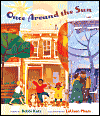 April is
April is
when the earth
parades in a green so brand-new
you can almost hear it playing a tune,
turning tight buds
of forsythia bushes
into tiny yellow trumpets…
And here is how she begins her poem about May:
May is
when the sky unties
a secret song bag
early every morning,
and the birds fly out…
I love these images Katz fashions with words. They are fresh. They certainly aren’t trite or clichéd.
Signs of Spring
I was an elementary teacher for many years. I still remember the ubiquitous “spring is” writing exercises we teachers often had children do in class to celebrate the arrival of spring. Often the children’s poems came out something like this:
Spring is flowers
and birds singing.
Spring is green grass
and warm weather.
Spring is when
I fly my kite.
Speaking from my experience as a classroom teacher, I can tell you that once I began sharing all kinds of poetry with my students, many of them began writing poetry with more inventive images like those found in the poems written by Bobbi Katz and with more of the elements of language characteristic of poetry. I think it’s equally important to give children ample time to carefully observe the world around them in mid-spring--to give them opportunities to really look at, study, and think about the changes in nature. They will then be more likely to write poems with more depth, poems that express their personal thoughts and feelings.
Let’s look at excerpts from some other excellent poems about spring that would be great to share with children.
The poems in John Updike’s A CHILD’S CALENDAR are filled with examples of particular sights, sounds, and smells that he associates with each month of the year. Here are two examples of similes he uses to describe two signs of spring from his poem about March.
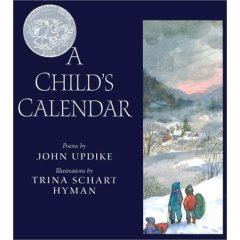
From March
The sun is nervous
As a kite
That can’t quite keep
Its own string tight…
Pale crocuses
Poke through the ground
Like noses come
To sniff around.
Imagine comparing the spring sun to a nervous kite and crocuses to noses sniffing around.
In PIECES: A YEAR IN POEMS & QUILTS, Anna Grossnickle Hines writes poetry about all four seasons. Here are excerpts from Do You Know Green?, which is one of her poems about spring.

Green comes…
tickling the tips
of twiggy tree fingers…
poking up as tiny
slips of baby grass…
bursting out on bare
brown branches…
Look at how Hines uses personification here. In her poem, green is poking and bursting and tickling twiggy tree fingers.
One of the jobs of a poet is to be precise with language, to select just the right words to express thoughts and feelings, and to help readers picture the poet’s written images in their minds. Pointing out to students poets’ similes, metaphors, imagery, use of personification and alliteration, and selected use of words helps them to better understand the elements of language often found in poetry and helps expand their writing vocabulary and knowledge of the genre.
(I found making transparencies of poems and showing them to students on an overhead projector was a fine way to lead my students into a brief discussion of the poems.)
In A CIRCLE OF SEASONS, Myra Cohn Livingston makes wonderful use of personification to bring spring and all its wonders alive.
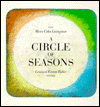
From
A CIRCLE OF SEASONS:
Spring skips lightly on a thin crust of snow,
Pokes her fragrant fingers in the ground far below,
Searches for the sleeping seeds hiding in cracked earth,
Sticks a straw of sunshine down and whispers words to grow:
O seed
And root
Send forth a tiny shoot!Capturing a Feeling
Some children may prefer to write about their personal feelings about spring—as Katz did in
Spring Is— rather than make a list of things that come to mind when asked to write about the season.
In her poem entitled
Spring, Karla Kuskin expresses the excitement a child feels when spring has arrived. Kuskin speaks in the voice of an exuberant youngster.
Her poem begins:
I’m shouting
I’m singing
I’m swinging through trees
I’m winging sky-high
With the buzzing black bees…
The poem ends…
I’m a bud
I’m a bloom
I’m a dove on the wing.
I’m running on rooftops
And welcoming spring.And in Kuskin’s poem
Spring Again, a child anticipates all the things she/he will do during this season of rebirth.
From
Spring Again:
Buds on the branches
a breeze in the blue
and me without mittens
my sweater unbuttoned
a spring full of things
all before me to do.Focusing on One Sign/Aspect of SpringIn
Mud Flood, a poem in Douglas Florian’s collection
HANDSPRINGS, the author talks about mud oozing on shoes and boots and pants and shirts and about the only way to get clean again—with suds.

From
Mud Flood
The spring rains came
And made a flood
So now there’s mud
and mud
and mud.Lilian Moore’s
Forsythia Bush is another of my favorite spring poems. In the poem Moore wrote how the forsythia…
explodes
into yellow
and
startles the street into spring.It’s not just any poet who would think to use verbs like “explodes” and “startles” in a poem about a plant!
In
Pussy Willows, Aileen Fisher speaks of rubbing Spring across the cheek of someone whose eyes are closed—Spring in this case being exemplified as “smooth as satin, soft and sleek” pussy willows.
In
The Spring Wind, Charlotte Zolotow describes the spring wind as “smelling of spring and growing things/brushing the world with feathery wings.”
If you can locate a copy of Aileen Fisher’s book
OUT IN THE DARK AND DAYLIGHT (Harper & Row, 1980), you will find a treasure trove of poems that focus on different signs/aspects of spring: pussy willows, mud in March, buttercups, an early bee, a robin’s song, clover, frogs, the sounds of spring, leaf buds.
Yes, share poems such as these with children and their words will implant images and rhythmic language in their minds that will serve as a poetic treasure chest for them to reach into when the time comes for them to write their own poems about spring.
Where to find the poems cited in this blog article if a book title has not been noted above:SPRING IS by Bobbi Katz
Puddle Wonderful: Poems to Welcome Spring, selected by Bobbi Katz
The Random House Book of Poetry for Children, selected by Jack Prelutsky (page 42)
Sunflakes: Poems for Children, selected by Lilian Moore (page 54)
FORSYTHIA BUSH by Lilian Moore
I Thought I Heard the City, written by Lilian Moore
Puddle Wonderful: Poems to Welcome Spring, selected by Bobbi Katz
Something New Begins, written by Lilian Moore (page 32)
SPRING by Karla Kuskin
Dogs & Dragons, Trees & Dreams, written by Karla Kuskin (page 14)
Moon, Have You Met My Mother?: The Collected Poems of Karla Kuskin (page 112)
Puddle Wonderful: Poems to Welcome Spring, selected by Bobbi Katz
The Random House Book of Poetry for Children, selected by Jack Prelutsky (page 43)
Ring Out Wild bells: Poems about Holidays and Seasons, selected by Lee Bennett Hopkins (page 25)
The 20th Century Children’s Poetry Treasury, selected by Jack Prelutsky (page 24)
SPRING AGAIN by Karla Kuskin
Dogs & Dragons, Trees & Dreams, written by Karla Kuskin (page 14)
Moon, Have You Met My Mother?: The Collected Poems of Karla Kuskin (page 111)
 For Lunch:
For Lunch:













 April is
April is


 From
From
Omygosh... my sister made me go to Trader Joe's when I went back home (here in the woods we don't have one) and I have to say I didn't really understand it. :-O
Paula, I think of you every time I use my shake Parmesan in a can after a post you made ages ago, lol. You'll be happy to know the still-life I'm working on has real Parmesan in it.